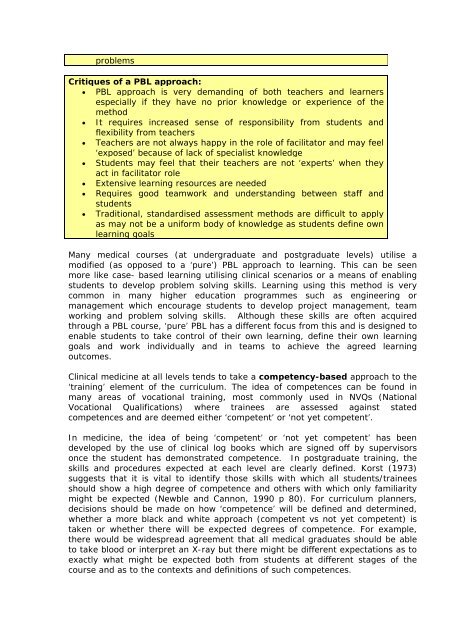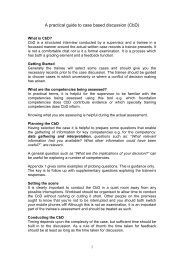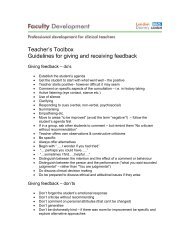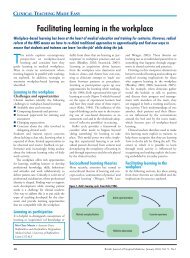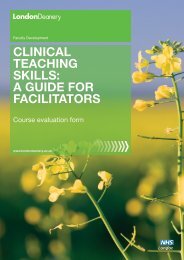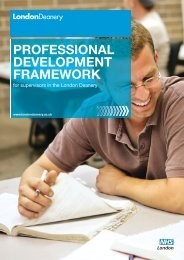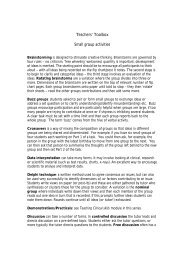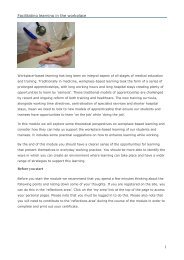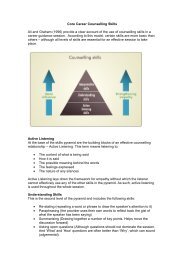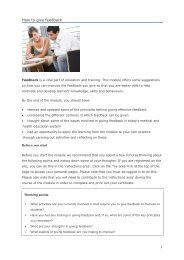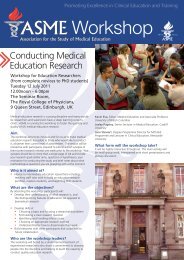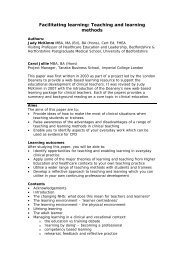Curriculum development module - Faculty Development - London ...
Curriculum development module - Faculty Development - London ...
Curriculum development module - Faculty Development - London ...
Create successful ePaper yourself
Turn your PDF publications into a flip-book with our unique Google optimized e-Paper software.
problems<br />
Critiques of a PBL approach:<br />
• PBL approach is very demanding of both teachers and learners<br />
especially if they have no prior knowledge or experience of the<br />
method<br />
• It requires increased sense of responsibility from students and<br />
flexibility from teachers<br />
• Teachers are not always happy in the role of facilitator and may feel<br />
‘exposed’ because of lack of specialist knowledge<br />
• Students may feel that their teachers are not ‘experts’ when they<br />
act in facilitator role<br />
• Extensive learning resources are needed<br />
• Requires good teamwork and understanding between staff and<br />
students<br />
• Traditional, standardised assessment methods are difficult to apply<br />
as may not be a uniform body of knowledge as students define own<br />
learning goals<br />
Many medical courses (at undergraduate and postgraduate levels) utilise a<br />
modified (as opposed to a ‘pure’) PBL approach to learning. This can be seen<br />
more like case- based learning utilising clinical scenarios or a means of enabling<br />
students to develop problem solving skills. Learning using this method is very<br />
common in many higher education programmes such as engineering or<br />
management which encourage students to develop project management, team<br />
working and problem solving skills. Although these skills are often acquired<br />
through a PBL course, ‘pure’ PBL has a different focus from this and is designed to<br />
enable students to take control of their own learning, define their own learning<br />
goals and work individually and in teams to achieve the agreed learning<br />
outcomes.<br />
Clinical medicine at all levels tends to take a competency-based approach to the<br />
‘training’ element of the curriculum. The idea of competences can be found in<br />
many areas of vocational training, most commonly used in NVQs (National<br />
Vocational Qualifications) where trainees are assessed against stated<br />
competences and are deemed either ‘competent’ or ‘not yet competent’.<br />
In medicine, the idea of being ‘competent’ or ‘not yet competent’ has been<br />
developed by the use of clinical log books which are signed off by supervisors<br />
once the student has demonstrated competence. In postgraduate training, the<br />
skills and procedures expected at each level are clearly defined. Korst (1973)<br />
suggests that it is vital to identify those skills with which all students/trainees<br />
should show a high degree of competence and others with which only familiarity<br />
might be expected (Newble and Cannon, 1990 p 80). For curriculum planners,<br />
decisions should be made on how ‘competence’ will be defined and determined,<br />
whether a more black and white approach (competent vs not yet competent) is<br />
taken or whether there will be expected degrees of competence. For example,<br />
there would be widespread agreement that all medical graduates should be able<br />
to take blood or interpret an X-ray but there might be different expectations as to<br />
exactly what might be expected both from students at different stages of the<br />
course and as to the contexts and definitions of such competences.


